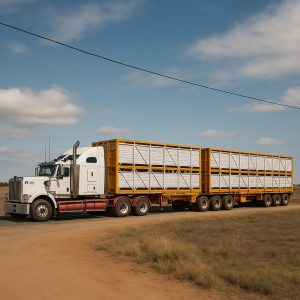Automated Safety
Farm Safety
Farm Management
Automated Safety
Farm Safety
Farm Management
Can You Afford an Accident on Your Farm?
By James Diamond, March 31, 2025
When accidents happen on farms, the impacts are often profound, extending far beyond immediate physical injuries. They can result in significant emotional distress, operational disruption, and devastating financial losses. In Australia, the stakes are particularly high, with stringent occupational health and safety (OHS) regulations enforced through hefty fines, enforceable undertakings, and costly litigation processes. This article explores the real costs associated with farm accidents and asks farmers a critical question: Can you truly afford to overlook safety?

The Real Costs of Farm Accidents
While the immediate aftermath of an accident might be clear—injury, property damage, disruption—many farmers underestimate the extensive hidden costs. These can include legal fees, fines, higher insurance premiums, reputational damage, and profound emotional tolls. To illustrate, let’s examine two real-world Australian incidents highlighting just how costly these accidents can be.
Case Study 1: The Cost of a Lost Finger – Over AUD $500,000
In one recent case, an Australian agricultural company faced substantial financial repercussions after an employee lost a finger due to insufficient safety measures around machinery. While the physical injury was serious, the financial consequences proved even more severe:
- Medical treatment and rehabilitation costs: Immediate and ongoing medical expenses quickly accumulate.
- Loss of productivity: Downtime for injured employees and disruption to regular operations.
- Legal costs: Hiring lawyers to manage the case and negotiate with safety authorities.
- Fines and penalties: Enforceable undertakings, imposed by SafeWork authorities, often carry substantial monetary obligations aimed at improving safety practices.
- Insurance premium hikes: Insurers invariably raise premiums after significant claims, affecting financial planning for years.
The total financial impact on this company surpassed half a million Australian dollars—a sum significant enough to jeopardise operational viability for smaller farms.
Case Study 2: Near-Death Experience of a Contractor – Millions in Liabilities
Another severe incident involved a cattle transport contractor who narrowly escaped death after an incident on a farmer’s property. This scenario unfolded due to inadequately maintained equipment and a lack of proper safety protocols. The subsequent investigation resulted in the farm facing enormous financial and legal repercussions:
- Immediate medical expenses and emergency response: Rapidly escalating medical bills and costs for emergency responders.
- Compensation and legal settlements: Claims for pain, suffering, ongoing care, and compensation for lost income.
- Enforceable undertaking commitments: Extensive investments mandated by SafeWork inspectors, including safety upgrades, training programs, and community education initiatives.
- Legal fees and regulatory fines: Costs involved in the lengthy legal battle and imposed penalties.
Ultimately, the farmer faced millions in liabilities. These costs, coupled with reputational damage, placed enormous stress on their financial resources and operational sustainability.

The High Price of Non-Compliance
Enforceable undertakings (EUs) represent legally binding agreements between businesses and state safety regulators. While designed to improve workplace safety proactively, EUs often require significant financial commitments. Typical conditions include:
- Extensive safety audits and upgrades.
- Development and implementation of comprehensive safety management systems.
- Regular staff training and education initiatives.
- Public safety awareness campaigns.
These undertakings not only demand substantial financial investment but also require ongoing commitments that divert time and resources from core business activities.
The Hidden Costs: More Than Just Money
While financial costs are significant, they represent only part of the broader impact of farm accidents.
Emotional and Psychological Impacts
Accidents can cause profound emotional distress, affecting not only the injured parties but also their families and colleagues. The psychological trauma can lead to long-term mental health issues, reducing productivity and morale across the workforce.
Reputational Damage
Farms that experience serious accidents often face severe reputational damage within their communities and industry. Loss of trust can result in decreased business opportunities, difficulties in hiring quality staff, and strained relationships with contractors and suppliers.
Operational Disruptions
Accidents lead to significant disruptions in daily operations, including downtime due to investigations, equipment repairs, or replacement. Such disruptions inevitably impact productivity and profitability.
Cost-Benefit Analysis: Can You Afford Not to Invest in Safety?
Farmers often perceive safety measures as burdensome expenses. However, the cost-benefit analysis clearly favors proactive safety investment:
- Preventative measures: Investing in modern safety equipment, training programs, and emergency communication systems substantially reduces the risk of costly incidents.
- Long-term savings: Minimising accidents leads to lower insurance premiums, fewer legal issues, and sustained productivity.
- Enhanced reputation: Farms recognised for high safety standards attract quality employees, contractors, and market opportunities.
Mitigating Risks: Practical Steps Farmers Can Take
Understanding the immense costs associated with farm accidents, proactive measures become essential:
Step 1: Regular Safety Audits and Risk Assessments
Regularly conduct thorough safety audits to identify hazards and mitigate risks proactively.
Step 2: Invest in Training and Education
Continuous safety education and training empower employees to recognise and manage potential hazards effectively.
Step 3: Equip Workers with Appropriate Safety Devices
Provide reliable communication devices (e.g., satellite communicators, personal locator devices) to ensure rapid response during emergencies.
Step 4: Maintain Machinery and Infrastructure
Regular maintenance prevents breakdowns and accidents associated with faulty equipment.
Step 5: Foster a Safety Culture
Encourage open communication about safety concerns, fostering a workplace culture where safety is prioritised.
The Bottom Line
Considering the potential catastrophic financial, emotional, and operational impacts of farm accidents, investing in safety is not just prudent—it’s essential. Farmers must recognise that the upfront cost of comprehensive safety measures pales in comparison to the potential expenses and repercussions of an accident.
When asking yourself whether you can afford a serious incident on your farm, consider the true costs—beyond immediate expenses and into long-term financial stability and sustainability.
Safety investment isn’t just a regulatory requirement; it’s a cornerstone of successful farm management. It’s time to make safety an integral part of your operational strategy—because the costs of inaction are simply too high.
For tailored support in developing and implementing robust farm safety measures, email the team on hello@airagri.com.au
